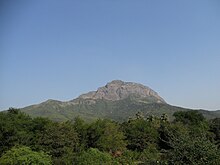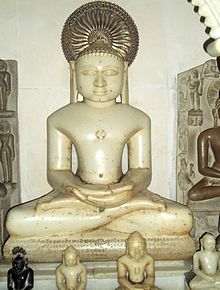Neminatha
Neminatha was the 22nd Tirthankara in Jainism . It is said to have been around in the 32nd century BC. Chr. In northern India have lived.
birth
Neminatha ( Devanagari : नेमिनाथ), also called Arishtanemi , was the son of the King of Sauripura Samudravijaya , who came from the Harivamsa line of succession ( Sanskrit : हरिवंश) , and his wife, Queen Shivadevi (meaning Sauripura or Sauryapura near Dvaraka in Uttar Pradesh , not to be confused with Dvaraka in Gujarat ). He was born on the 5th day of the 22nd Nakshatra (Indian lunar house) Shravana Shukla . His grandfather was Andakavrishni and his uncle Vasudeva , the father of Krishna and Balaramas . His birth was celebrated with great celebrations.
Moved to Dvaraka
Due to his arguments with Jarasandha , who was besieging Mathura , Krishna decided to move with his entourage to Dvaraka in Gujarat ( Vishnu parva , chapters 55-56).
marriage
According to Vedic custom , Neminatha's marriage was arranged. This task was taken over by his cousin and at the same time spiritual disciple Krishna, who had chosen Rajamati, the daughter of Ugrasenas and the sister of his wife Satyabhama for the occasion . Neminatha rode his decorated elephant for this ceremony, which was attended by thousands of kings and princes and their entourage. On the way they passed a huge game reserve. When Neminatha asked his elephant handler why the animals were locked up here, he got the answer that they should be slaughtered to entertain the guests. Shaken and deeply moved, Neminatha ordered the animals to be released. He also turned around with his entourage and moved back to Dvaraka. When asked about the reason for his unusual behavior, Neminatha replied, “Just as these animals were locked up, we are all trapped in our karma . Contentment and happiness are based on freedom, not coercion. Please do not stop me, I am choosing the path of everlasting peace. "
renunciation

After a year of charity work in Dvaraka, Neminatha left the city and went to the outlying garden of Raivatak. On the sixth day of the month of Shravana, he disposed of all his belongings under an Ashoka tree in the presence of thousands of other people. Five times he reached into his hair with his hand and removed it. From then on he led the ascetic life of a shramana . After 54 days of spiritual immersion, he moved to Mount Girnar . There he attained the state of omniscience on the afternoon of the 15th day in the month of Ashvin and thus became the 22nd Tirthankara - a Siddha , a liberated soul who has left all karmic effects behind. Rajamati, his bride, also followed Neminatha's example and founded the Sandhvi Sangh , an association for ascetic women.
presentation
In Jainism, Tirthankaras occupy a godlike, privileged position. Neminatha is usually depicted in a sitting or standing, meditative posture. His body color is black . A conch shell is assigned to him as a symbol. His protective yaksha is Gomedh, his yakshini is Ambika .
Teaching
It is very likely that the sage Gora Angirasa mentioned in the Chandogya Upanishad is identical to Neminatha.
Ghora Angirasa gave Krishna the following spiritual principles:
Abstinence, acceptance, simplicity, non-violence and truthfulness .
These principles have become fundamental elements of Jainism, which is largely based on ahimsa .
temple
The Shri Neminatha Temple (श्रीनेमिनाथ) was built between 1128 and 1159 at the location on Mount Girnar where Neminatha obtained Moksha . It consists of several rectangular courtyards with columns on the passageways. These were neatly engraved and show next to Neminatha the images of various Tirthankaras. Figures of dancing goddesses are attached to the ceilings. The temple also contains a figure of Neminatha made of black granite , whose eyes are filled with large jewels. Also worth mentioning is the temple Shri Neminath Adhisthayaka Nagotra Solanki Gotria Kuladevi Shri Ambikadevi Jinalaya in Santhu near Bagra in Rajasthan. Here Neminatha is worshiped together with his yakshini, mother Ambika.
historicity
In historical studies, Jainism, located in the Ganges basin of northern India, can be traced back to the 7th century BC. To be traced back, i.e. H. to Parshva , the 23rd Tirthankara, which is historically documented. In the Jain scriptures, however, a list of a total of 24 tirthankaras is given, which must therefore go back much further in time. If Neminatha's family connection with Krishna corresponds to the facts - Krishna was allegedly his older cousin - then the 32nd century BC can be the date of Neminatha's ministry. Be viewed.
Neminatha is also mentioned along with Rishabha in the Rigveda . His story of Jinasena is told in great detail in Harivaṃśapurāṇa , which dates from the year 783 AD and describes the events from a Jainist point of view.
literature
- Jain Bhawan: Jain Journal . Ed .: Jain Bhawan. Volumes 2-3, 1967.
- Shashi Ahluwalia and Meenakshi Ahluwalia: Living faiths in modern India . Indian Publishers' Distributors, 1992.
- Vilas Adinath Sangave: Facets of Jainology . Popular Prakashan, 2001.




